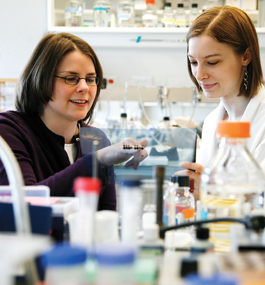The Beauty of Basic Research

Mike Lovett
Suzanne Paradis (left) with a student.
by Leah Burrows
Like countless scientific advances, this one was never anticipated. Suzanne Paradis, an assistant professor of biology, and her scientific team doubted their experiment would even work, much less turn out to be a potential treatment for epilepsy.
Call it the beauty and the beast of basic research: Despite the best-laid plans, research sometimes yields the unexpected — occasionally with delightful results.
Paradis’ experiment started with a question: How are GABAergic synapses built?
The mammalian brain has two main types of synapses: excitatory, or glutamatergic, and inhibitory, or GABAergic. If neuronal connections are the roadways carrying information throughout the brain, synapses are the intersections. Glutamatergic synapses act as a green light, triggering the movement of information. GABAergic synapses are a red light, stopping the information from proceeding to the next neuron.
Paradis, neuroscience PhD candidate Marissa Kuzirian, postdoctoral fellow Anna Moore and lab manager Emily Staudenmaier discovered that a protein called Sema4D is an essential synaptic building block. It was Kuzirian’s idea to add Sema4D to neurons. Would the cells build more GABAergic synapses?
“I thought it would never work,” Paradis recalls with a laugh. “No way.”
But she gave Kuzirian the go-ahead, and within 30 minutes the proof was under the microscope: dozens of new GABAergic synapses. Not only did the experiment work, Sema4D caused synapses to form much more quickly than Paradis and her team could have ever anticipated.
Next came the eureka moment. Since epileptic seizures are caused by too much neuronal excitation — green lights all the way — the team reasoned that building more GABAergic synapses would be like putting red lights on the Autobahn.
To test this theory, the team used a “seizure in a dish” model of epilepsy, triggering seizure-like conditions in a slice of mammalian tissue. They treated the neurons with Sema4D and waited. Within two hours, the electrical output of the neurons was almost back to normal.
Though the findings are early and require validation outside the tissue culture dish, they were significant enough to be published recently in The Journal of Neuroscience and to prompt Paradis to file a patent.
“We were not intending to study epilepsy, yet we discovered something we didn’t know before,” says Paradis. “Funding basic research is so important. You never know where the next big, groundbreaking discovery is going to come from.”
